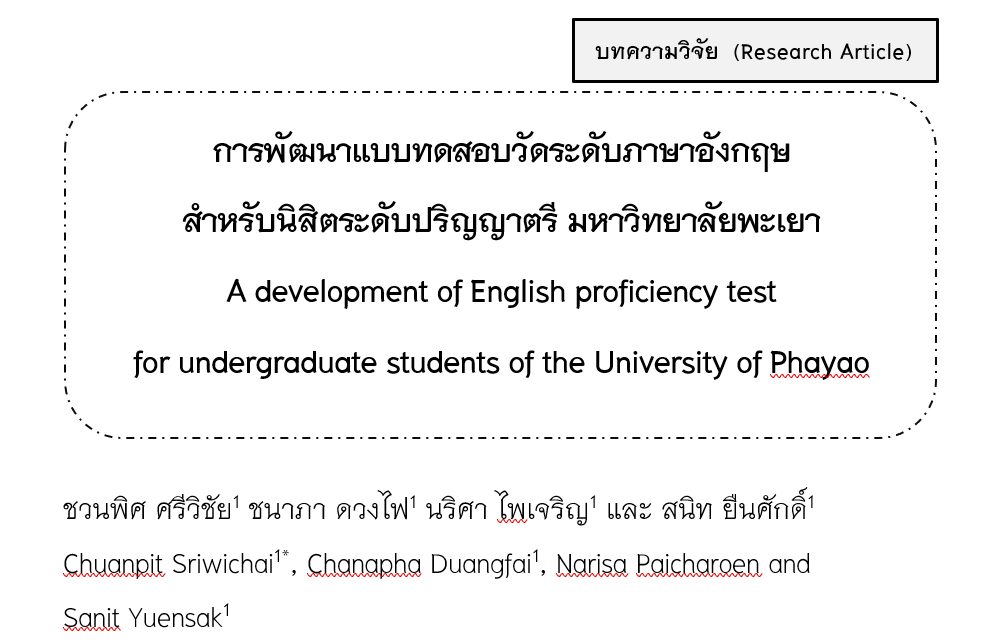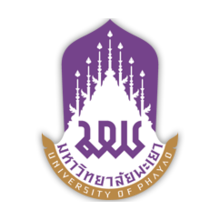A Development of English Proficiency Test for Undergraduate Students of the University of Phayao
Keywords:
English Proficiency Test, Undergraduate Students, University of PhayaoAbstract
This study aimed to develop English proficiency tests for undergraduate students of the University of Phayao based on the Common European Framework of Reference for Languages B 1 level and to evaluate the quality of the developed tests. There were 4 sets of the tests had been developed. Each set of the test consisted of 60 items, and it was divided into 4 parts including vocabulary, reading, grammar and writing, and conversation. There were 15 items in each part. The sample of this study were 227 third-year students from 18 faculties of the University of Phayao. The tests were verified content validity by 3 experts in the fields of English language and Education Evaluation and Assessment using Index of Item-Objective Congruence (IOC). Then the tests were tried out with the sample to analyze difficulty and discrimination based on 27 % technique of Chung-Teh-Fan. The criteria for index of difficulty and discrimination was the difficulty should be between 0.20 and 0.80 and discrimination should be at least 0.20. Next, the tests were analyzed reliability using KR-20 formula.
The findings showed that overall, the Index of item objective congruence (IOC) of the tests was between 0.33 – 1.00. The IOC of each test was between 0.92-0.93. In terms of the standardized quality of the difficulties and the discrimination of the test, there were 49 qualified items in the first test, 48 qualified items in the second test, 49 qualified items in the third test, and 50 qualified items in the fourth test respectively. The reliability of each test was between 0.79 and 0.87. This indicated a good quality of the tests.
References
จิตติรัตน์ แสงเลิศอุทัย. (2558). เครื่องมือที่ใช้ในการวิจัย (Research Instrument). วารสารบัณฑิตศึกษามหาวิทยาลัยราชภัฏสกลนคร, 12(58), 13-24.
เดชกุล มัทวานุกุล. (ม.ป.ป.) การวิจัยและพัฒนา (Research and Development). สืบค้น 15 มีนาคม 2564, จาก http://www.curriculum-instruction.com/index.php/journal.
สำนักงานคณะกรรมการการอุดมศึกษา. (2559, 12 เมษายน). ประกาศคณะกรรมการการอุดมศึกษา เรื่อง นโยบายการยก ระดับมาตรฐานภาษาอังกฤษในสถาบันอุดมศึกษา. กองยกระดับคุณภาพการจัดการศึกษาระดับอุดมศึกษา, จาก http://www.dqe.mhesi.go.th/front_home/Data%20Bhes_2559/04052559.pdf.
มหาวิทยาลัยพะเยา. (2562, 18 พฤษภาคม). ประกาศมหาวิทยาลัยพะเยา เรื่อง นโยบายการยกระดับมาตรฐานภาษาอังกฤษ สำหรับนิสิตมหาวิทยาลัยพะเยาพ.ศ.2562. ระบบบริการการศึกษา มหาวิทยาลัยพะเยา, จากhttps://does.up.ac.th/public/storage/announce-detail/May2020/ulVEBIlyia1JOynUfeZt.pdf.
มหาวิทยาลัยพะเยา. (2562, 18 พฤษภาคม). ประกาศมหาวิทยาลัยพะเยา เรื่อง มาตรฐานการทดสอบวัดระดับความรู้ภาษาอังกฤษสำหรับนิสิตระดับปริญญาตรี พ.ศ.2562. ระบบบริการการศึกษา มหาวิทยาลัยพะเยา, จากhttps://does.up.ac.th/public/storage/announce-detail/March2021/TyWUnNe1fZOgLyZvQFSf.pdf.
ชื่นจิตต์ อธิวรกุล และจิรดา วุฑฒยากร. (2561). การเทียบผลคะแนนแบบทดสอบสมิทธิภาพภาษาอังกฤษแห่งมหาวิทยาลัยศรีนครินทรวิโรฒกับกรอบมาตรฐานอ้างอิงสากลของยุโรป. วารสารเทคโนโลยีสุรนารี, 12(2), 69-84.
ณัฏฐภรณ์ หลาวทอง. (2547). รายงานการวิจัยเรื่อง การพัฒนาคลังข้อสอบวิชา 2702303 การวัดและการประเมินผลทางการศึกษาด้วยโปรแกรมคอมพิวเตอร์. กรุงเทพฯ: จุฬาลงกรณ์มหาวิทยาลัย.
ล้วน สายยศและอังคณา สายยศ. (2543). เทคนิคการวัดผลการเรียนรู้. กรุงเทพฯ: สุวีริยาสาส์น.
________. (2538). เทคนิคการวิจัยทางการศึกษา (พิมพ์ครั้งที่ 5). กรุงเทพฯ: สุวีริยาสาส์น.
สุกัญญา ทองนาค, ศิริชัย กาญจนวาสี และสุพจน์ เกิดสุวรรณ์. (2558). การพัฒนาแบบทดสอบวัดสมรรถนะนักศึกษาครุศาสตร์/ศึกษาศาสตร์ตามมาตรฐานวิชาชีพครูที่มีการตรวจให้คะแนนแบบพหุวิภาค.วารสารวิจัย มสด, 9(1), 169-187.
สังวรณ์ งัดกระโทกและคณะ. (2561). คุณภาพข้อสอบระดับชาติ (โอเน็ต) และแนวทางการพัฒนาคุณภาพการทดสอบ. วารสารสุโขทัยธรรมาธิราช, 31(2), 110-123.
สิรินธร สินจินดาวงศ์. (2547). วิธีการวิเคราะห์ข้อสอบ. วารสารศรีปทุมปริทัศน์, 4(1), 21-33.
สมชาย วรกิจเกษมสกุล. (2554). ระเบียบวิธีการวิจัยทางพฤติกรรมศาสตร์และสังคมศาสตร์. อุดรธานี: มหาวิทยาลัยราชภัฏอุดรธานี.
อลิสา วานิชดี, สุพิมพ์ ศรีพันธ์วรสกุล และนรินทร์ทิพย์ ทองศร. (2551). การพัฒนาแบบทดสอบวัดความสามารถด้านการใช้ภาษาอังกฤษ โดยใช้สื่ออิเล็กทรอนิกส์ในระบบการศึกษาทางไกล. กรุงเทพฯ: มหาวิทยาลัยสุโขทัยธรรมาธิราช.
Bachman, L. F. (1990). Fundamental considerations in Language Testing. Oxford: Oxford University Press.
Burns, N., Grove, S.K. & Sutherland, S. (2017). Burn and Grove’s the Practice of Nursing Research: Appraisal, synthesis, and generation of evidence (8th Edition). Missouri: Elsevier.
Council of Europe. (n.d.) Global scale - Table 1 (CEFR 3.3): Common Reference levels. Council of Europe, Form https://www.coe.int/en/web/common-european-framework-reference-languages/table-1-cefr-3.3-common-reference-levels-global-scale.
Lakhamja, R. & Tachom, K. (2022). Implementing Triangulation Teaching Techniques to Enhance English Speaking Skills for Thai Undergraduate Students. Journal of Humanities and Social Sciences University of Phayao, 10(2), 60-75.
Praimahaniyom, T. & Chairinkom, B. (2020). Developing GROUPS Model for Learning English Communication Skills: Kamphaeng Phet Rajabhat University, Maesot. Journal of Humanities and Social Sciences University of Phayao, 8(2), 16-42.

Downloads
Published
How to Cite
Issue
Section
License
Copyright (c) 2023 Phayao University

This work is licensed under a Creative Commons Attribution-NonCommercial-NoDerivatives 4.0 International License.
ผู้นิพนธ์ต้องรับผิดชอบข้อความในบทนิพนธ์ของตน มหาวิทยาลัยพะเยาไม่จำเป็นต้องเห็นด้วยกับบทความที่ตีพิมพ์เสมอไป ผู้สนใจสามารถคัดลอก และนำไปใช้ได้ แต่จะต้องขออนุมัติเจ้าของ และได้รับการอนุมัติเป็นลายลักษณ์อักษรก่อน พร้อมกับมีการอ้างอิงและกล่าวคำขอบคุณให้ถูกต้องด้วย
The authors are themselves responsible for their contents. Signed articles may not always reflect the opinion of University of Phayao. The articles can be reproduced and reprinted, provided that permission is given by the authors and acknowledgement must be given.







